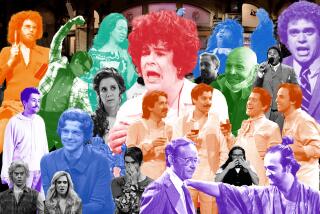ON PHOTOGRAPHY : THE DOOMSDAY VISION OF DEBORAH IRMAS
“The one thing you could always say about me is that I rub things against the grain.” Historian and curator Deborah Irmas was reflecting on her relationship with photography.
First, she explained, she had difficulty finding a school in the early ‘70s that would allow her to study photography in the context of art history, with all its sociological, political and cultural ramifications.
Then, the first major project she tackled was an exhibition of a hopelessly unfashionable, if not untouchable, subject: William Mortensen, a Romantic photographer who created arty battle scenes and literary themes with all the restraint of vintage Hollywood epics.
Now, at the San Francisco Museum of Modern Art through July 14, Irmas has organized an improbably intriguing show called “Signs of the Times: Some Recurring Motifs in 20th-Century Photography.” The exhibition of 225 works challenges the conventions of museum presentations on at least two counts. For one thing, it is critical of photographers’ failure to produce new images.
Citing the revolution in the field that took place in the ‘60s and then burned out, Irmas writes in the catalogue: “The aesthetics of photographic practice broadened, but the spoils from the battle were small. As it became acceptable to draw on a negative or print, enlarge it and print it as a cyanotype, it became less interesting to do so. Process was no longer a forbidden fruit. Subject matter, the most compelling component in photography, has not changed substantially with the barrage of new processes.”
Another deviation from standard museum practice is that “Signs of the Times” concentrates on developing an idea instead of showing the collection to its best advantage. “Museums always want to show their beautiful treasures instead of their dead weight. I think dead weight is important,” she asserted.
The largely unfamiliar photographs she selected for “Signs of the Times” either picture the human figure (or fragments of it) or objects made in the 20th Century. As those two strains weave through history, pictorial themes repeat themselves with significant changes. Pristine rows of gleaming manufactured products speak of fervent belief in progress in photos from the ‘20s and ‘30s, while recent shots picture the same objects taken for granted, used up, trashed and symptomatic of consumerist burnout.
Hein Gorny’s lineup of brand-spanking-new automobiles circa 1930 is supplanted by Robert A. Widdicombe’s 1979 row of clapped-out cars, up-ended and half buried as an art piece called “Cadillac Ranch.” Among a fascinating array of strange figurative images, the mysterious aura of floating heads, legs and arms, inspired by Surrealism, washes away with repetition or takes on a cynical tone as the years pass. Such alluring pictures as Lotte Jacobi’s 1929 “Head of a Dancer, Berlin” give way to Nancy Burson’s 1983 rendition of “Mankind” as a “computer-generated portrait of three major races proportioned to reflect current population statistics.”
Irmas did not set out to organize a show that would expose rampant despair or weaknesses of the field that consumes her professional energy. Invited to work at the museum for two months by Curator of Photography Van Deren Coke, she was hired to go through the collection print by print and earmark works for possible inclusion in one of the institution’s 50th anniversary exhibitions. “As I was looking, I came up with the theme of recurring motifs,” Irmas recalled. When her prescribed stint was over, she presented the idea to Coke, who not only approved it but secured funds for her to stay on, organize the show and publish a catalogue.
“I couldn’t have been in a more active, efficient or archivally accurate department, including the Museum of Modern Art in New York,” she said. “The material is really kept alive. It (working at the San Francisco museum) was the best experience of my career. Now I’m ready to take on longer projects here.”
Having just returned to her native Los Angeles after two years in San Francisco, Irmas is in a fluid state--assessing her past work while looking forward to new curatorial ventures and possibly writing a book on the history of Southern California photography.
At the end of her catalogue essay, she asks: “Is the dour tenor of contemporary photography the result of an ongoing pessimism that has afflicted our age? Is it the creative manifestation of an end-of-the-millenium malaise?” In print, she answers, “Perhaps,” but in person Irmas insists that the “doomsday vision” she sees all around her--on MTV and record albums as well as in photographs and other art--hasn’t got her down.
“No, I’m not pessimistic about photography. I have too much to do. I really enjoy going through masses of material, culling it and making something with it. That’s my joy and my talent.”
More to Read
The biggest entertainment stories
Get our big stories about Hollywood, film, television, music, arts, culture and more right in your inbox as soon as they publish.
You may occasionally receive promotional content from the Los Angeles Times.










